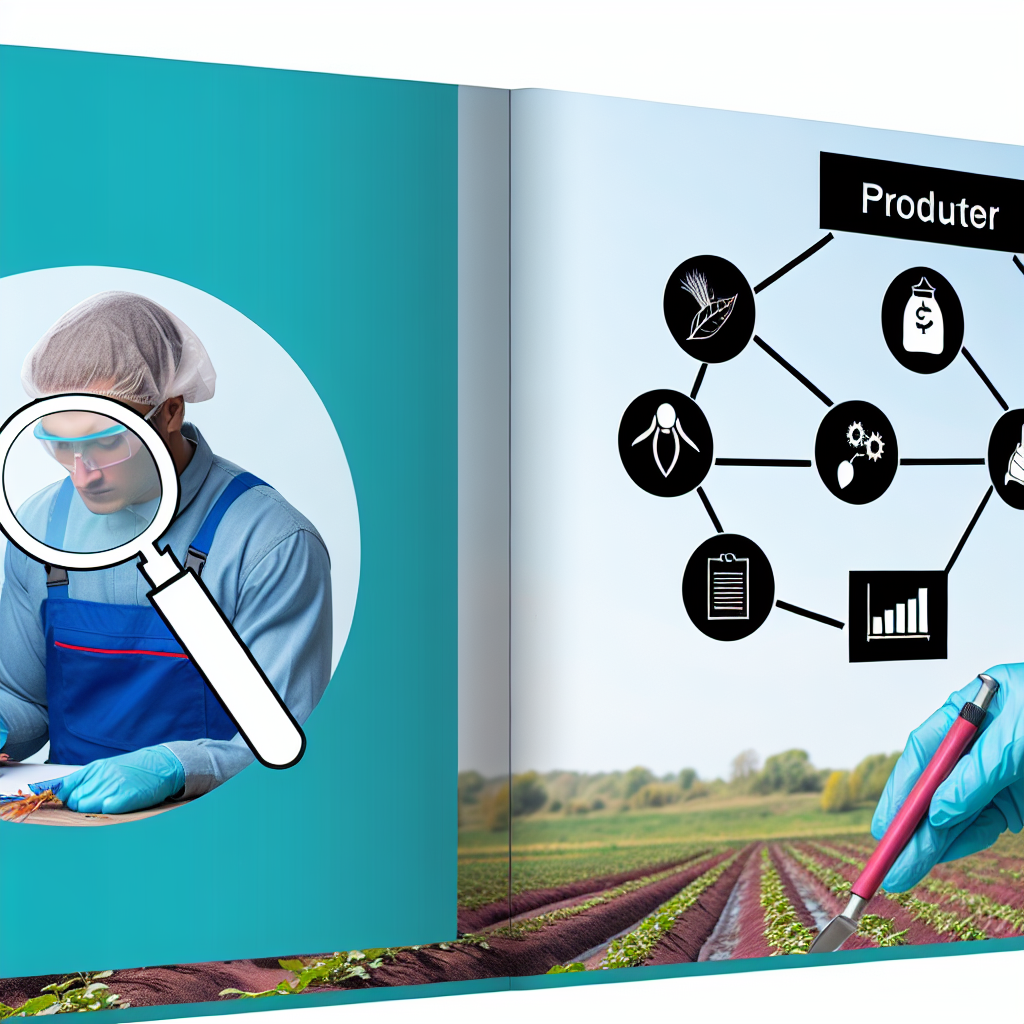Introduction to Food Safety Regulations in Agriculture
Food safety regulations play a critical role in agricultural production.
These regulations aim to ensure that our food supply remains safe and healthy.
They apply to every stage of the agricultural process, from production to distribution.
Understanding these regulations helps farmers meet safety standards effectively.
Moreover, compliance with food safety regulations enhances consumer trust.
The Importance of Food Safety Regulations
Food safety regulations protect consumers from foodborne illnesses.
They also promote fair trade practices among producers.
In fact, strict regulations can reduce the incidence of contamination.
Furthermore, they ensure the quality and safety of food products.
Consumers increasingly demand safe and quality agricultural products.
Key Components of Food Safety Regulations
Food safety regulations include guidelines on crop protection and soil health.
Farmers must adhere to specific pesticide application methods.
Additionally, proper handling and storage of products are crucial.
Traceability requirements allow for tracking products from farm to table.
Finally, sanitation standards on farms help minimize risks of contamination.
Transform Your Agribusiness
Unlock your farm's potential with expert advice tailored to your needs. Get actionable steps that drive real results.
Get StartedImpact on Agricultural Practices
Farmers often adjust their practices to comply with regulations.
This adaptation can involve changes in crop management techniques.
Moreover, education on food safety becomes essential for agricultural workers.
Training programs help workers understand safe food handling practices.
As a result, overall agricultural productivity can improve.
Challenges Faced by Farmers
Compliance with food safety regulations can be costly for farmers.
Smaller farms may struggle to meet these financial demands.
Additionally, understanding the regulations can be complex and time-consuming.
These challenges often lead to decreased profit margins.
However, many farmers see long-term benefits from compliance.
Overview of Key Food Safety Regulations Affecting Farmers
Food safety regulations significantly impact agricultural production.
These regulations ensure the safety and quality of food products.
Farmers must comply with various federal and state laws.
Federal Regulations
The Food Safety Modernization Act (FSMA) plays a crucial role.
It focuses on preventing food safety issues before they occur.
Farmers must adopt preventive controls and safety protocols.
Additionally, the USDA sets standards for organic and non-GMO products.
Compliance with these standards helps farmers access premium markets.
State Regulations
States implement specific food safety measures as well.
These measures often align with federal regulations but may differ.
Local health departments inspect farms for compliance.
Farmers must stay updated on their state’s requirements.
Impact on Agricultural Practices
Food safety regulations influence farming practices directly.
Farmers may need to revise their production methods.
Showcase Your Farming Business
Publish your professional farming services profile on our blog for a one-time fee of $200 and reach a dedicated audience of farmers and agribusiness owners.
Publish Your ProfileThis can include changing pest management strategies.
Moreover, they must ensure proper sanitation in facilities.
Record-keeping becomes essential to demonstrate compliance.
Challenges for Farmers
Adhering to food safety regulations presents challenges.
Many small farmers struggle with the costs of compliance.
They may lack the resources to implement necessary changes.
Furthermore, misunderstanding of regulations can lead to violations.
Benefits of Compliance
Despite challenges, compliance offers several advantages.
Farmers can enhance their marketability through safety certifications.
They also build consumer trust by prioritizing food safety.
In the long run, adherence can reduce the risk of recalls.
The Role of Government Agencies in Enforcing Food Safety Standards
Overview of Food Safety Agencies
Government agencies play a crucial role in food safety enforcement.
These agencies establish regulations to protect public health.
Organizations such as the FDA and USDA are key players.
They monitor food production processes to ensure compliance.
Development of Food Safety Regulations
Regulations are based on scientific research and risk assessments.
Agencies analyze potential hazards in food production.
This informs the creation of comprehensive safety standards.
Furthermore, collaboration with industry stakeholders is essential.
Inspections and Compliance
Regular inspections are vital to maintain food safety standards.
Inspectors evaluate farms, processing plants, and distributors.
This proactive approach helps identify risks quickly.
Noncompliance can lead to significant penalties for producers.
Utilizing Technology for Safety
Government agencies increasingly use technology to enhance food safety.
Data analytics play a key role in monitoring compliance.
Additionally, advancements in traceability systems improve accountability.
These tools help prevent foodborne illnesses effectively.
Public Education and Resources
Education is a critical component of food safety regulation.
Agencies provide resources and training for producers.
They promote awareness of food safety practices among consumers.
Workshops and outreach programs facilitate better understanding.
Challenges in Enforcement
Enforcing food safety regulations presents unique challenges.
State and federal agencies often face resource constraints.
Moreover, differing regulations can complicate compliance.
Addressing these challenges requires ongoing adjustments and improvements.
Delve into the Subject: Environmental Impact Assessments in Agriculture
Impact of Food Safety Regulations on Crop Production Practices
Overview of Food Safety Regulations
Food safety regulations aim to protect public health.
They establish standards for growing, handling, and processing food.
These regulations affect a wide range of agricultural practices.
Changes in Crop Production Techniques
Farmers must adapt their techniques to comply with new regulations.
Showcase Your Farming Business
Publish your professional farming services profile on our blog for a one-time fee of $200 and reach a dedicated audience of farmers and agribusiness owners.
Publish Your ProfileFor instance, they may implement better sanitization practices.
This involves cleaning tools and equipment more frequently.
Furthermore, they often use improved pest management systems.
Integrated pest management reduces chemical residues on crops.
Impact on Fertilizer and Pesticide Use
Food safety regulations influence how fertilizers are applied.
Producers must adhere to guidelines regarding application rates.
This ensures that residual chemicals do not pose health risks.
Likewise, regulations stipulate safe pesticide applications.
Farmers often rely on certified pesticides to meet these requirements.
Cost Implications for Farmers
Compliance with food safety regulations can raise production costs.
Investing in new technology often requires significant funding.
Additionally, training staff on safety protocols incurs further expenses.
These costs may impact the overall profitability of farms.
Some farmers may struggle to absorb these additional expenses.
Effects on Market Access
Adopting food safety standards can open new market opportunities.
Retailers often require compliance for their suppliers.
This can increase competition among farmers for premium markets.
Consequently, well-compliant farmers may enjoy higher profit margins.
However, non-compliance can lead to losing market access entirely.
Consumer Impact
Food safety regulations ultimately aim to protect consumers.
Compliance leads to safer, high-quality food products.
As a result, consumer trust in agricultural products increases.
This increased trust can benefit compliant farmers significantly.
Moreover, it encourages overall industry improvements.
Learn More: Overview Of Organic Farming Regulations
Effects of Food Safety Compliance on Livestock Farming
Overview of Food Safety Regulations
Food safety regulations play a crucial role in livestock farming.
They ensure that meat and dairy products meet health standards.
These regulations help prevent foodborne illnesses in consumers.
Compliance Challenges for Farmers
Farmers face numerous challenges in meeting these regulations.
For instance, they must constantly update their farming practices.
This can lead to increased operational costs and resource allocation.
Additionally, training staff on compliance procedures is essential.
Impact on Livestock Health
Food safety regulations significantly influence livestock health.
Farmers are required to implement strict hygiene practices.
This reduces the risk of disease transmission among animals.
Ultimately, healthier livestock contributes to better product quality.
Market Access and Demand
Compliance with food safety regulations can improve market access.
Consumers increasingly demand safe and high-quality meat products.
Meeting these standards enhances farmers’ reputations in the market.
Consequently, they can potentially charge higher prices for their products.
Showcase Your Farming Business
Publish your professional farming services profile on our blog for a one-time fee of $200 and reach a dedicated audience of farmers and agribusiness owners.
Publish Your ProfileTechnological Advancements
Many farmers turn to technology to aid compliance efforts.
Automation helps streamline operations and reduce human error.
For example, tracking systems monitor livestock health in real-time.
Furthermore, data-driven insights lead to informed decision-making.
Long-term Sustainability
Food safety regulations encourage sustainable farming practices.
Farmers are motivated to embrace ecologically sound methods.
These practices not only improve compliance but also product quality.
In the long run, sustainable practices benefit both farmers and consumers.
Discover More: Essential Steps for Farmers to Apply for Research and Development Grants

Economic Implications of Food Safety Regulations for Farmers
Overview of Food Safety Regulations
Food safety regulations aim to protect consumers from foodborne illnesses.
They set standards for production, processing, and distribution in agriculture.
These regulations vary by country and may frequently change.
Impact on Farmers’ Costs
Compliance with food safety regulations can increase operational costs for farmers.
Farmers often invest in training and equipment to meet safety standards.
Additionally, they may face costs related to inspections and certifications.
Higher costs can reduce profit margins if prices remain constant.
Market Access and Competitiveness
Food safety regulations may impact farmers’ access to markets.
Strict regulations can act as a barrier to entry for smaller producers.
However, compliance can open doors to premium markets and exports.
Farmers who meet safety standards can gain a competitive edge.
Benefits of Adhering to Safety Standards
Adhering to food safety regulations enhances consumer trust in products.
Trust can lead to increased sales and brand loyalty over time.
Moreover, compliance can reduce the risk of recalls and legal liabilities.
Farmers may also benefit from improved product quality and shelf life.
Government Support and Resources
Many governments provide resources to help farmers comply with regulations.
These resources can include training programs and financial assistance.
Farmers can leverage local agricultural extensions for guidance.
Staying informed about available support is crucial for success.
Discover More: Understanding Farm-To-Table Legislation: A Comprehensive Guide for Farmers
Challenges Faced by Small-Scale Farmers in Adhering to Regulations
Understanding the Regulations
Food safety regulations can be complex and hard to navigate.
Small-scale farmers often struggle to understand these regulatory frameworks.
Moreover, each region may enforce different rules.
This creates confusion and potential compliance issues.
Financial Burdens
Adhering to food safety regulations can be costly for small farmers.
They may need to invest in new equipment or facilities to comply.
Additionally, hiring experts for consultations can add financial strain.
Consequently, some farmers may find it difficult to stay profitable.
Time Constraints
Compliance with food safety standards requires significant time investment.
Farmers often juggle multiple tasks, leaving little time for regulatory compliance.
This time crunch can lead to inconsistent adherence to safety measures.
Showcase Your Farming Business
Publish your professional farming services profile on our blog for a one-time fee of $200 and reach a dedicated audience of farmers and agribusiness owners.
Publish Your ProfileAs a result, they may face penalties or legal issues.
Access to Resources
Many small-scale farmers lack access to vital resources.
These resources include training programs focused on food safety.
Additionally, they might have limited access to information on best practices.
Consequently, this could hinder their ability to meet safety standards.
Market Competition
Small farmers often face stiff competition from larger operations.
These larger farms often have more resources for compliance.
As a result, smaller farms may struggle to compete on a level playing field.
This disparity can lead to reduced market share and lower profit margins.
Impact on Production Choices
Due to stringent regulations, some farmers change their production methods.
They may rely on fewer crops to simplify compliance.
This narrowing can affect biodiversity and sustainability over time.
Ultimately, it can limit their ability to adapt to market demands.
Future Trends in Food Safety Regulations and Their Potential Impact on Agriculture
Adoption of Technology in Food Safety
Innovative technologies will revolutionize food safety regulations.
Farmers will increasingly use sensors and IoT devices to monitor product conditions.
Data analytics will enhance decision-making processes in agricultural practices.
Consequently, producers can ensure compliance with regulatory standards more effectively.
Increased Global Standards
Countries will adopt more stringent global food safety standards.
This trend will push local farmers to adopt international best practices.
As a result, agricultural exports may improve due to better safety ratings.
Additionally, compliance will require ongoing training and education for workers.
Focus on Sustainable Practices
There will be a growing emphasis on sustainable agricultural practices.
Regulations will incentivize organic farming and eco-friendly production methods.
This shift will align food safety controls with environmental protection goals.
Ultimately, sustainable practices may lead to healthier food options for consumers.
Consumer Transparency and Traceability
Consumers demand greater transparency from food producers.
Regulations are likely to enforce traceability in food supply chains.
As a result, farmers must implement comprehensive tracking systems.
This change will help build consumer trust and ensure food quality.
Potential Economic Implications
Implementing stringent food safety measures may increase production costs.
Consequently, some farmers might face financial challenges in compliance.
Conversely, higher safety standards could lead to premium pricing opportunities.
Thus, balancing safety, cost, and profitability will become vital for producers.




